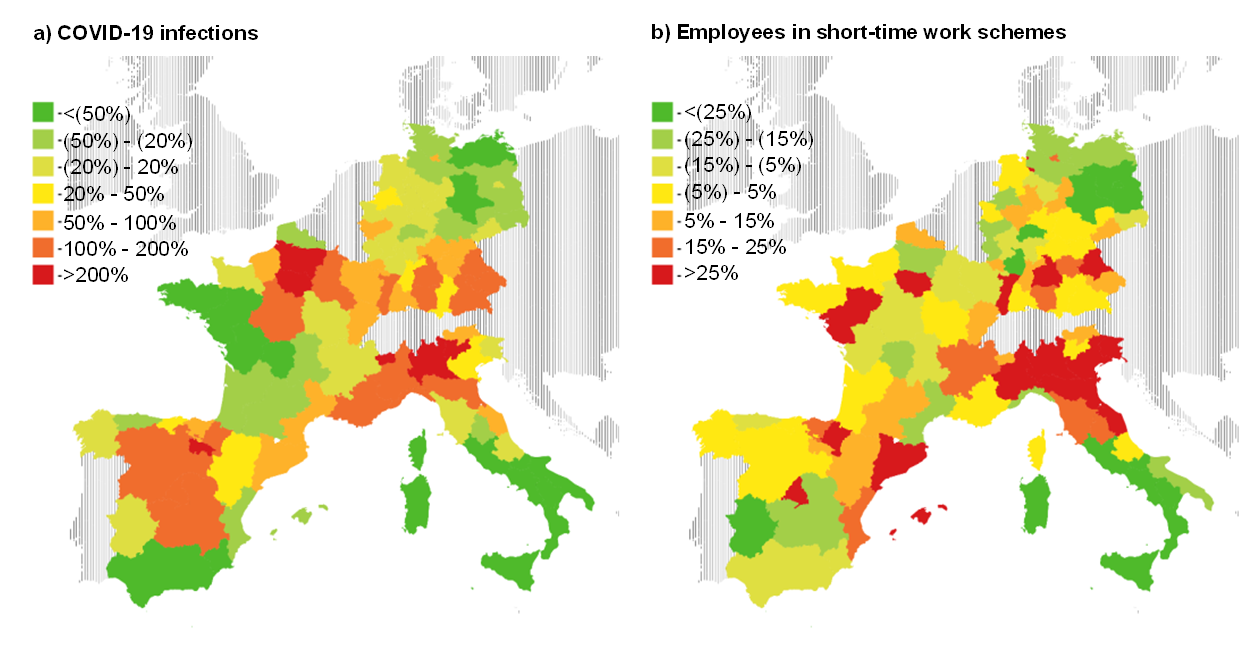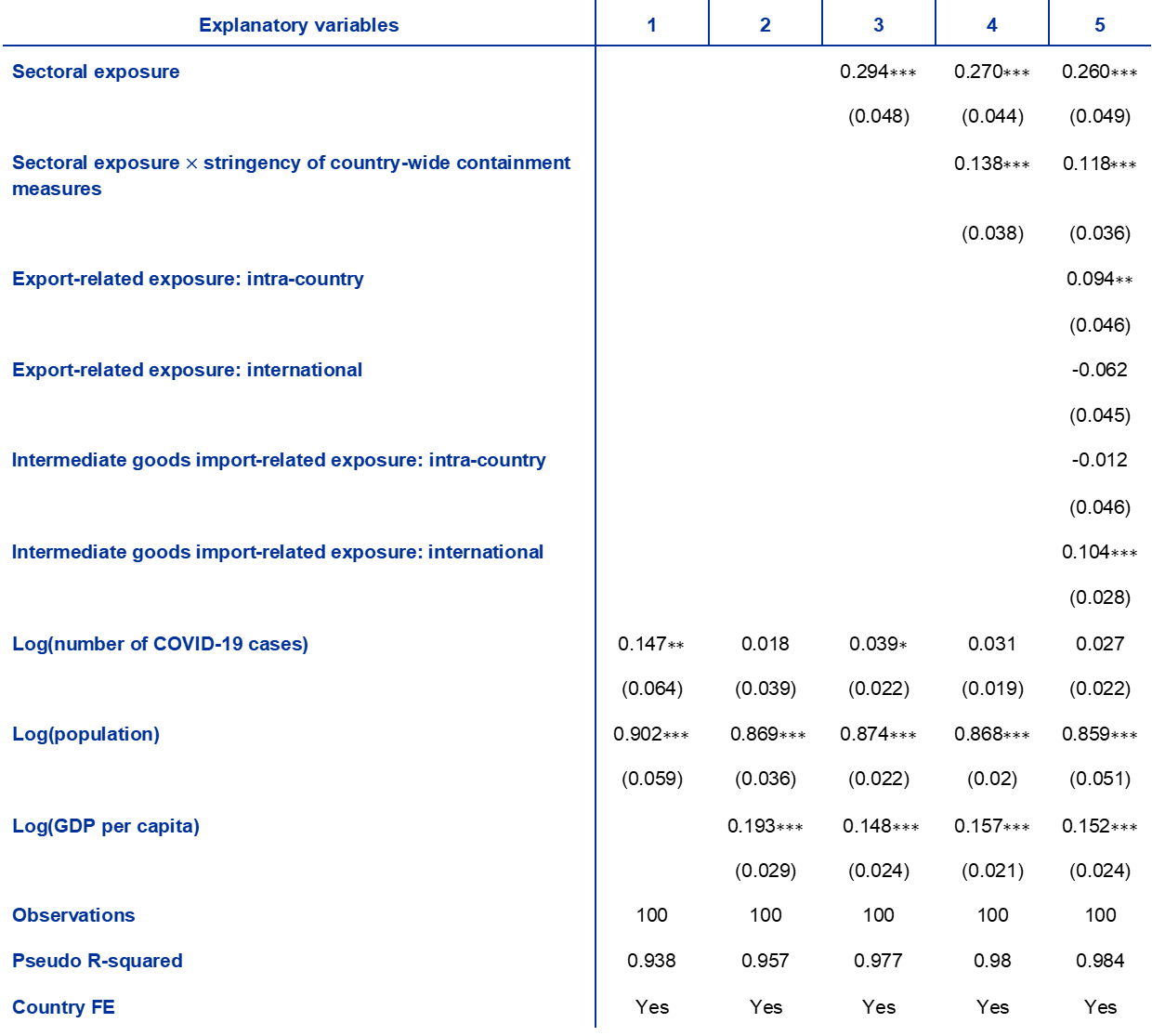The economic impact of the pandemic – drivers of regional differences
Published as part of the ECB Economic Bulletin, Issue 1/2021.
This box examines the drivers of intra-country regional differences in the economic impact of the coronavirus (COVID-19), as observed in the four largest euro area economies during the initial phase of the pandemic. More specifically, it discusses the role played by sectoral structure and trade linkages in explaining the difference in terms of how COVID-19 affects the regions within these countries economically.
During the first phase of the pandemic, the economic impact of the crisis was evident in severe labour market disruptions, affecting local labour markets to varying degrees. The number of employees in short-time work schemes, one of the main policy tools used to contain lay-offs, spiked dramatically in France, Germany, Italy and Spain during the first wave of the COVID-19 pandemic.[1] These spikes were characterised by significant regional variations, displaying a pattern that did not fully mirror the intra-country geographical distribution of the disease (Chart A), highlighting the need to identify the other factors at play.
Chart A
Within-country variation in employees in short-time work schemes and COVID-19 infections
(Deviation from country-specific median)

Sources: National sources and ECB staff calculations.
Notes: Figures refer to (cumulated) numbers of March and April in 2020. Regional COVID-19 infections and employees in STW are normalised by regional population. Regions are defined according to the 2-digit level of the NUTS classification. STW refer to Cassa Integrazione Guadagni (Italy), Expediente de Regulacion Temporal de Empleo (Spain), Activite’ Partielle (France) and Kurzarbeit (Germany).
The first possible driver of the heterogeneous labour market impact of COVID-19 is the interaction between country-wide containment measures and the sectoral structures of different regions. In particular, sectors are exposed to government restrictions to varying degrees, depending, for instance, on the extent to which social distancing can be ensured at work and/or work-related activities can be performed remotely. Since sectoral activities are unevenly distributed across the regions within an individual country, the degree to which these regions are exposed to the COVID-19 shock differs accordingly. In order to investigate this point empirically, we generate a measure of regions’ sectoral exposure by first combining sector-level data about employees’ susceptibility to the virus whilst at work[2] and the capacity to perform tasks remotely[3], before using regional sector employment shares from Eurostat to aggregate the data at the regional level. Furthermore, we calculate an indicator of stringency of country-wide containment measures by combining data on workplace closures, limits on the size of private gatherings, shelter in place orders and restrictions on internal movement.[4]
In addition to the direct impact related to its sectoral structure, a region’s trade relations with other regions heavily exposed to the COVID-19 shock could also be a further cause of economic burden. Indeed, regional supply chains can represent a powerful indirect channel for the propagation of the crisis, both through international trade and interconnections between regions within a country. More specifically, a region’s activity may be affected by a shortfall in the supply of intermediate goods sourced from other regions heavily affected by the virus and/or by a drop in demand for its exports. In order to investigate this point empirically, we generate measures of regional trade-related exposure based on inter-regional input-output tables, which make it possible to consider both intra-country and international trade flows for each region.[5]
The results of empirical analysis support the hypotheses referred to above, showing that the different economic impact of COVID-19 across regions cannot be explained solely by the spread of infections, while both a region’s sectoral structure and its trade linkages are relevant determinants. We employ a regression framework to investigate the role of regions’ sectoral structures and trade linkages in explaining intra-country variation in the number of people in short-time work within the four largest euro area economies (Table A). First, the results in columns 1 and 2 illustrate that the variable controlling for the regional number of COVID-19 cases becomes insignificant once regional GDP per capita is accounted for, indicating that, during the first wave of the pandemic, regions with a high incidence of COVID-19 cases had relatively high average income (e.g. regions in northern Italy, southern Germany and the Paris and Madrid areas). Second, the results show that a region’s sectoral structure is an important determinant of the economic consequences of COVID-19: a region with a sectoral exposure measure of one standard deviation higher has, on average, 30% more employees in short-time work schemes (column 3). Furthermore, this effect increases with the stringency of national containment measures (column 4). Finally, the results suggest that trade linkages can be an additional indirect channel through which coronavirus-related disruptions affect regional economic activity (column 5).[6]
Table A
Drivers of intra-country regional heterogeneity in the number of employees in short-time work
(Coefficient estimates and standard errors (in parenthesis); dependent variable: regional number of employees in short-time work schemes)

Sources: National sources; INAIL, op. cit.; Dingel and Neiman, op. cit.; Eurostat, Labour Force Survey; Hale et al., op. cit.; Thissen et al., op. cit..
Notes: The table presents Poisson regressions. The dependent variable is the cumulative number of people in short-time work schemes in each of the NUTS 2 regions in France, Germany, Italy and Spain by the end of April 2020. All variables vary across regions and are standardised to have a mean of zero and a standard deviation of one. Robust standard errors in parentheses: *** p < 0.01, ** p < 0.05, * p < 0.1. McFadden's pseudo R-squared is calculated as 1-ll(model)/ll(null) where ll refers to the log likelihood.
- For more details about short-time work schemes, see the box entitled “A preliminary assessment of the impact of the COVID-19 pandemic on the euro area labour market”, Economic Bulletin, Issue 5, ECB, 2020.
- Based on “Documento tecnico sulla possibile rimodulazione delle misure di contenimento del contagio da SARS-CoV-2 nei luoghi di lavoro e strategie di prevenzione”, INAIL, 2020.
- Based on Dingel, J. and Neiman, B., “How many jobs can be done at home?”, CEPR Discussion Papers, No DP14584, April 2020.
- Based on Hale, T., Angrist, N., Cameron-Blake, E., Hallas, L., Kira, B., Majumdar, S., Petherick, A., Phillips, T., Tatlow, H. and Webster, S., “Oxford COVID-19 Government Response Tracker”, Blavatnik School of Government, 2020.
- We measure export-related exposure by combining data about each region’s share of output sold to other regions, the sectoral exposure of the other regions and the stringency of containment measures in the countries where the partner regions are located. Intermediate goods import-related exposure is calculated based on data about the share of intermediate goods sourced from other regions in the region’s total output and the exposure of these other regions to the virus owing to their sectoral structure and the prevailing containment measures. Note that we distinguish between intra-country regional trade and international trade. The inter-regional input-output tables are obtained from Thissen, M., Ivanova, O., Mandras, G. and Husby, T., “European NUTS 2 regions: construction of interregional trade-linked Supply and Use tables with consistent transport flows”, JRC Working Papers on Territorial Modelling and Analysis, No 01/2019, European Commission, 2019.
- On the one hand, this relates to shortfalls in demand for a region’s exports, an effect which is present for intra-country exports only (see the variable “Export-related exposure: intra-country”). On the other hand, when considering the role of supply linkages, international trade becomes relevant (see the variable “Intermediate goods import-related exposure: international”). Further analysis suggests that the latter effect is driven wholly by international trade within EU borders, highlighting vulnerabilities which may arise from disruptions to highly integrated EU supply chains.


